| کد مقاله | کد نشریه | سال انتشار | مقاله انگلیسی | نسخه تمام متن |
|---|---|---|---|---|
| 6210301 | 1266210 | 2015 | 7 صفحه PDF | دانلود رایگان |
Introduction and objective: Total knee arthroplasty (TKA) affects 1-3% of the entire population. The effectiveness of surgery and rehabilitation are of great significance. The goal of this study was to determine how different surgical methods (i.e., conventional and minimally invasive) influence balancing ability in response to sudden unidirectional perturbation during the first 12Â weeks of the postoperative period. Materials and methods: The balancing capacity after sudden unidirectional (horizontal) perturbation of 10 patients who had undergone TKA operations via the conventional method and 10 patients who had undergone TKA operations via the minimally invasive method were examined before and six and 12Â weeks after TKA. Forty-five health age-matched participants composed the control group. The balancing capacities following unidirectional perturbation were characterised by the Lehr's damping ratio, which was calculated based on the results of the provocation tests that were performed with the patients standing on both the affected and non-affected limbs. Results: In both patient groups, the Lehr's damping ratios increased during the postoperative period. However, in both patient groups, the Lehr's damping ratios calculated from the results of all three of the testing methods decreased compared to values obtained from the controls even at 12Â weeks postoperatively. Six and 12Â weeks after TKA, the Lehr's damping ratios of the patients who underwent operations utilising the minimally invasive exposure method were significantly higher than the values obtained from the patients who underwent operations by conventional exposure. Discussion and conclusions: In both patient groups, the balancing capacities continuously improved over the first 12Â weeks of the postoperative period, but the dynamic balancing capacities while standing on both limbs, on the affected limb and on the non-affected limb significantly differed from those of the controls. The balancing capacities of the patients who underwent the minimally invasive exposure procedures improved more rapidly than did the capacities of the patients who underwent operations utilising the conventional exposure method. This reduced balancing capacity should be considered when developing dynamic balancing abilities and abandoning therapeutic aids, and the difference in dynamic balancing abilities between the two patient groups should also be considered.
Journal: Journal of Electromyography and Kinesiology - Volume 25, Issue 3, June 2015, Pages 508-514
